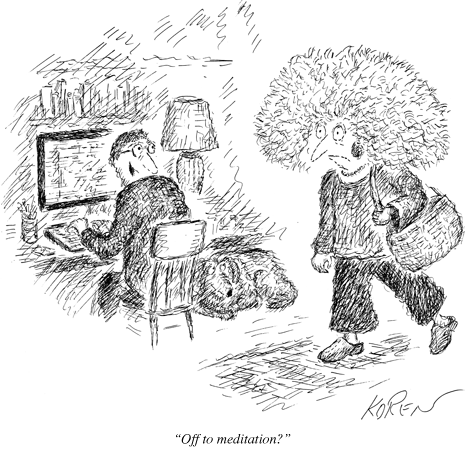Having trouble sleeping? Try meditating! In a recent piece on The New York Time‘s Opinionator blog, “How to Sleep on a Plane,” Virginia Heffernan writes:
As you learn how to fall asleep on planes—the Vipassana Buddhist tradition of meditation gives especially good results, I’ve found—you’ll attend to the interaction of their bodies with technology and design. In doing so, you may wonder what took them so long. You may think about other bodies and technology. You may come to study airplanes and specific flights.
You should ask, and determine, How many are here for business, and how many for pleasure? What is business and what is pleasure? Was this flight necessary? What will these passengers find on one and another end of their flights? What was life like before we moved our bodies through the air so fast and so far every day?
All the while, you’ll acquire a skill. Plane sleep is among the most rewarding and satisfying and even impressive skills a modern person can acquire. And this is how a curriculum based around the acquisition of skills can expand understanding, open new questions and strengthen minds.
Vipassana can help wake you up, vipassana can help you fall asleep! This is good news for plane pilgrims, but is it an appropriate way to practice? Is is commendable to use an ancient religious technology for such a mundane modern technology problem? I asked Sharon Salzberg.
“You can use vipassana to help you fall asleep,” Salzberg says. “Some people are worried about that actually, thinking they will habituate themselves to falling asleep whenever they are meditating. But it isn’t all about slumber. Vipassana meditation can help us relax, but in meditation we’re practicing calm wakefulness.”
The sub-headline of the NYT’s piece asks: Does the ability to achieve unconsciousness on a plane indicate, in fact, a higher consciousness? A few of the reader comments were Buddhistly bent.
Vipassana IS a very effective technique for gaining a measure of mastery over one’s own mind. I have used it successfully myself to bring on sleep, as well as to end a very serious depression. No kidding…
Another commenter wants the quick path to enlightenment:
I guess you could walk the long path of enlightenment and arrive at some sort of Zen state where you merge with the plane, and yada yada yada. Quicker would be if the flight attendants could give you a shot of that stuff they gave me when I had a colonoscopy. If a doctor can duct tape a flashlight to a garden hose and introduce it to one’s nether regions without disturbing one’s blissful slumber, then I’m sure I could sleep through anything the airlines could dish out.
Whoa. Mentioning your colonoscopy is always a trump card… Let’s move on. Here’s a cartoon in the current New Yorker:

Sure she’s frazzled, but the nerd on the computer looks like he’s getting way too much pleasure out of seeing her that way. He should go meditate with her.
In other news, Zen teacher and writer Lin Jensen has a new blog.
If you still find yourself unable to sleep on planes, allow me to make one final suggestion: practice detachment. As a throwback article that was recently reposted on the Buddhism Now blog, “Tantric View of Nonattachment,” reminds us:
It is one of the many paradoxes of the spiritual path that the greatest enjoyment comes through detachment. Tantra teaches us to enjoy consciously, to enjoy with awareness, but awareness itself simultaneously causes and is the result of a subtle movement of detachment. This is not an external distancing of oneself from life or from people, but an inner separation from the lower, limited self, with its false perceptions of the external world.
If we can detach ourselves from this desire to sleep on a plane, we will stop grasping at and struggling with our inability to do it. We experience inner peace. Of course, when we’re peaceful, it’s always easy to sleep.